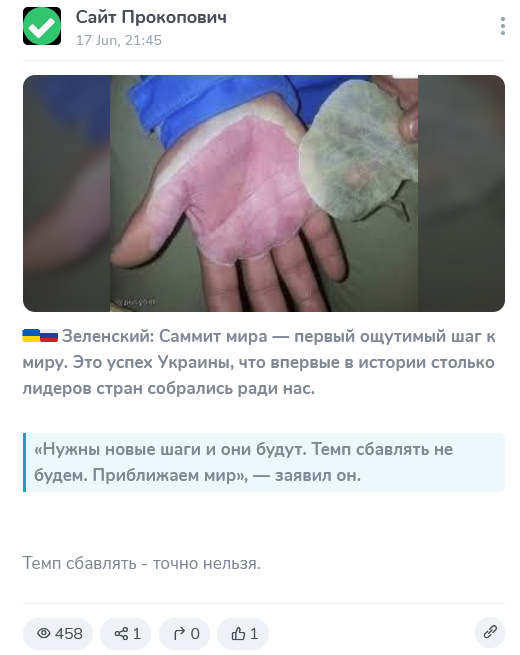June 15-16, 2024, the Summit on Peace in Ukraine, initiated by Ukraine, took place at the “Bürgenstock” hotel in the canton of Nidwalden, Switzerland. The aim of the conference was to hold a high-level discussion on a “comprehensive, just, and lasting peace for Ukraine” in the context of international law and the United Nations Charter, as well as to develop plans to achieve peace.
Representatives from 93 countries participated in the conference, with leaders from 57 countries attending, along with 8 international organizations.
Final Document:
The countries that signed the document recognize all countries within their internationally recognized borders, including Ukraine, and advocate for the resolution of conflicts by peaceful means. Ukrainian nuclear power plants, including Zaporizhzhia, must operate safely under Ukrainian control.

In the document, the signatories expressed support for the basic UN General Assembly resolutions regarding Russian aggression against Ukraine, condemning the Russian invasion and calling for the complete withdrawal of Russian troops from Ukraine.
The document declares the inadmissibility of threats to use nuclear weapons in the context of Russia’s invasion of Ukraine. Safe and free navigation in the Black and Azov Seas is crucial for global food security. Agricultural products from Ukraine should be supplied to countries interested in these products.
There must be a complete exchange of prisoners of war. All Ukrainian civilians, including children, who were illegally transferred across the border and deported, must return to Ukraine.
Coverage of the Summit on Peace in Belarusian Telegram Channels
Telegram channels in Belarus are important sources of news information used by both independent Belarusian media and state-owned media, as well as numerous toxic channels that often spread various disinformation narratives. In many cases, these disinformation narratives represent Russian information narratives, especially when it comes to the Russian military invasion of Ukraine. Based on this, it was expected that there would be a lot of false information about the Summit on Peace in Belarusian Telegram channels. Consequently, questions arise regarding the number of publications, their views, influence, and interconnections.
The data collection period was from June 1 to June 30.
Using the Telegram analytics service TGStat, a dataset of 214 posts mentioning the “Summit Peace” / “Саммит мира” (cyrillic) was collected. These posts garnered 3,767,919 views. All posts were made exclusively by Belarusian Telegram channels. The total number of channels studied was 98.
Analysis of Mentions
Telegram channels were divided into three groups based on their content, and a table was prepared showing the total number of views and posts by sentiment of the channels:
| Posts | Views | |
| Positive: | 82 | 2,784,314 |
| Negative: | 114 | 973,545 |
| Neutral | 18 | 10,060 |
The number of publications and views by days and sentiments in June 2024:

As seen from the graph, on the days of the Summit on Peace, Telegram channels with positive content made the most publications and gathered the most views because these were channels with several hundred thousand subscribers. It is also clear that after the end of the Summit, channels with positive content stopped making publications mentioning the conference. Channels with negative news content continued to make publications in which they talked about the failure of the conference and suggested that the next conference might involve the Russian Federation, presenting this information as a failure of Ukrainian diplomacy.
Cluster Analysis
Using the social network analysis tool NodeXL, a graph of channels that reposted from other Telegram channels was constructed. The final graph contains 72 nodes. The result after cluster analysis is as follows:

From this graph, it is clear that channels with negative content more often repost from each other. On the other hand, a “bouquet” of toxic channels, which publish simultaneously, did not have reposts from less affiliated Telegram channels on this topic.
It is important to demonstrate that automatic channel labeling was not sufficient, as shown in examples 1 and 2:


Thus, if analyzing only the text content of these posts, it appears neutral. However, if you study the images and videos, it is clear that these posts are toxic in content.
Conclusions
From the example of the Summit on Peace in Ukraine conference, it is worth noting that in long-term communication, maintaining the topic in the informational agenda plays an important role. This is especially important when it is a significant and sensitive topic and there is an opposing side with an aggressive disinformation agenda.
Increasing automation and the use of various generative artificial intelligence models facilitate the work of recognizing unreliable, fake information in various formats (text, images, photos, videos), but disinformation spreaders also use the latest technologies, and this often requires manual verification and labeling of information.
Disinformation spreaders are more organized and thus more analyzable information sources than sources of truthful information. However, to reach various target audiences and achieve greater coverage, even considering audience overlap, it makes sense to further study how to most effectively disseminate information and convey communication messages.
An updated source of information about the Summit on Peace in Ukraine:
June 2024 Ukraine peace summit









